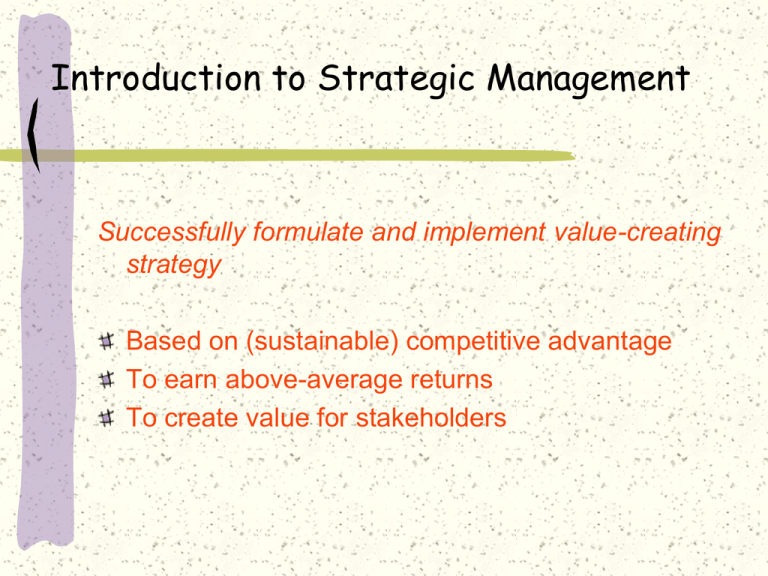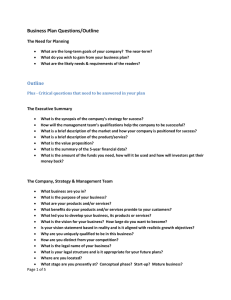6-Introduction to Strategic Management
advertisement

Introduction to Strategic Management Successfully formulate and implement value-creating strategy Based on (sustainable) competitive advantage To earn above-average returns To create value for stakeholders Introduction to Strategic Management Strategic Management Process Strategic Inputs: Internal and External Scanning Strategic Actions: Formulation and implementation of strategy Strategic Outcomes: Above, at or below average returns Introduction to Strategic Management From Organizational Vision to Tactical Steps Define the Organization: Vision Mission Statement Understand the Operating Environment External Environment (Threats and Opportunities) Internal Conditions (Strengths and Weaknesses) Determine Strategic Alternatives Formulate Strategy (long term) Implement Strategy through Tactics (short term) Introduction to Strategic Management SWOT Analysis External Analysis – EFAS Matrix (Chapter 3) Internal Analysis IFAS Matrix (Chapter 4) Strategy Formulation Alternative Strategies – TOWS Matrix (Chapter 5) Corporate Strategy (Chapter 6) Functional Strategy (Chapter 7) Strategy Implementation Organizing (Chapter 8) Staffing (Chapter 9) Evaluating (Chapter 10) Introduction to Strategic Management The New Competitive Landscape The Global Economy Movement of goods, services, capital/financing, technology and innovation, information, and people across borders Introduction to Strategic Management The New Competitive Landscape The Global Economy Competitive Implications Managing supply and logistics (raw materials, components manufacturing, assembly, distribution) Adaptation-standardization decisions in management practices and marketing programs Introduction to Strategic Management The New Competitive Landscape Technology and Technological Change Increasing Rate of Change Increasing Rate of Diffusion Competitive Implications Impact of Technology Convergence. Application of Nanotechnology. Introduction to Strategic Management The New Competitive Landscape Information Intensity Declining costs Increasing accessibility Knowledge Intensity (Information, Intelligence, Expertise) Increasing proportion of shareholder value Strategic Flexibility, Capacity to Learn & Reorient Introduction to Strategic Management The New Competitive Landscape Information and Knowledge Intensity Competitive Implications Knowledge management systems (SAP) Control versus flexibility (strategic alliances) Introduction to Strategic Management Mission of Firm Clearly articulate 3-5 year plan of firm Identify: The industry(ies) it wishes to participate in How it wishes to participate Marketing mix (product, price, place, promotion Customer “wants and needs” it will serve Position it will hold in its chosen markets Introduction to Strategic Management Mission is: What is the ultimate accomplishment – goal for the firm? Usually stated in the “eyes” of the customers and key stakeholders “How” it is achieved (core competencies of the firm) Introduction to Strategic Management Examples of Vision and Mission Statements Vision: S C Johnson Mission Statement: Proctor & Gamble Dilbert’s Mission Statement Generator Introduction to Strategic Management What leads to a formulating a new strategy? •New CEO •External intervention Triggering events •Threat of change in ownership •Performance gap •Strategic inflection point Stimulus for change in strategy Introduction to Strategic Management Strategy: Levels and Dynamics Corporate: general perspective towards growth and management of various business units, product lines, functional areas Business: Strategic Business Units (SBUs), focus on improvement of competitive position of products and services Functional: focus on marketing, R & D, etc. to achieve SBU and overall corporate objectives. Introduction to Strategic Management Corporate goals and objectives include: –Profitability (net profits) –Growth (increase in total assets, etc.) –Utilization of resources (ROE or ROI) –Market leadership (market share) Introduction to Strategic Management Intended Strategy Deliberate Strategy Realized Strategy Unrealized Strategy Emergent Strategy Introduction to Strategic Management The Importance of Stakeholders Capital Market Stakeholders - shareholders and major suppliers of firm’s capital Product Market Stakeholders - primary customers, suppliers, host communities, and unions Organizational Stakeholders - employees (managerial and non-managerial) Societal Stakeholders - environmental and social responsibility organizations Governments Employees Investors, Shareholders and Lenders Supply Chain Associates Private Organizations THE CORPORATION Local Communities and Citizens Customers and Users Unions Joint Venture partners and Alliances Regulatory Authorities Governments Joint Venture partners & Alliances Supply Chain Associates Investors: Shareowners & Lenders Employees Unions Local communities & Citizens CORPORATION Customers & Users Regulatory Authorities RESOURCE BASE INDUSTRY STRUCTURE SOCIAL POLITICAL ARENA Private Organizations Community Relations “Frankenstein Foods” GMOs Strategic alliances EU Approvals; Import licenses Suppliers Investors Employees: - US - Global EPA regulations Greenpeace MONSANTO Customers: - Domestic - Global Global Joint ventures RESOURCE BASE INDUSTRY STRUCTURE SOCIAL POLITICAL ARENA Environmental Issues






